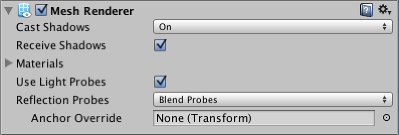Mesh Renderer
The Mesh Renderer takes the geometry from the Mesh Filter and renders it at the position defined by the object’s Transform component.

Propiedades
| Propiedad: | Función: |
|---|---|
| Cast Shadows | If enabled, the mesh will create shadows when a shadow-casting Light shines on it. The options are On and Off to enable/disable shadows, Two Sided to allow shadows to be cast from either side of the mesh (ie, backface culling is not taken into account) and Shadows Only (ie, the shadows should be visible but not the mesh itself). |
| Receive Shadows | If enabled, the mesh will display any shadows being cast upon it. |
| Materials | A list of Materials to render the model with. |
| Use Light Probes | Enable probe-based lighting for this mesh. |
| Use Reflection Probes | Enable probe-based reflections for this mesh. |
| Anchor Override | A Transform used to determine the interpolation position when the light probe or reflection probe systems are used. |
Detalles
Meshes imported from 3D packages can use multiple Materials. All the materials used by a Mesh Renderer are held in the Materials list. Each submesh will use one material from the materials list. If there are more materials assigned to the Mesh Renderer than there are submeshes in the mesh, the first submesh will be rendered with each of the remaining materials, one on top of the next. At a cost of performance, this will let you set up multi-pass rendering on that submesh. Fully opaque materials, however, will simply overwrite the previous layers, costing performance for no advantage.
A mesh can receive light from the light probe system and reflections from the reflection probe system depending on the settings of the Use Light Probes and Use Reflection Probes options. For both types of probe, a single point is used as the mesh’s notional position probe interpolation. By default, this is the centre of the mesh’s bounding box, but you can change this by dragging a Transform to the Anchor Override property (the anchor override affects both types of probe). It may be useful to set the anchor in cases where an object contains two adjoining meshes; since each mesh has a separate bounding box, the two will be lit discontinuously at the join by default. However, if you set both meshes to use the same anchor point then they will be consistently lit.